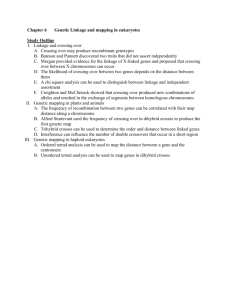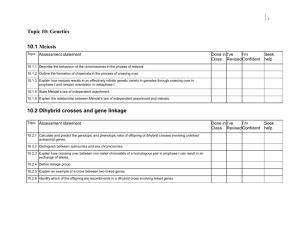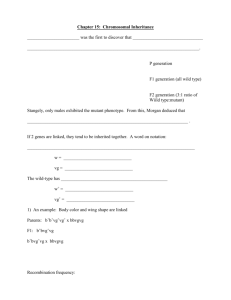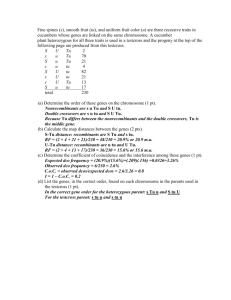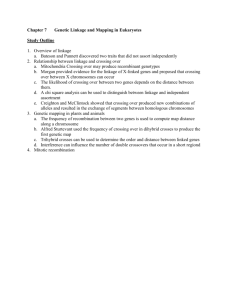Lecture 15 – PDF
advertisement
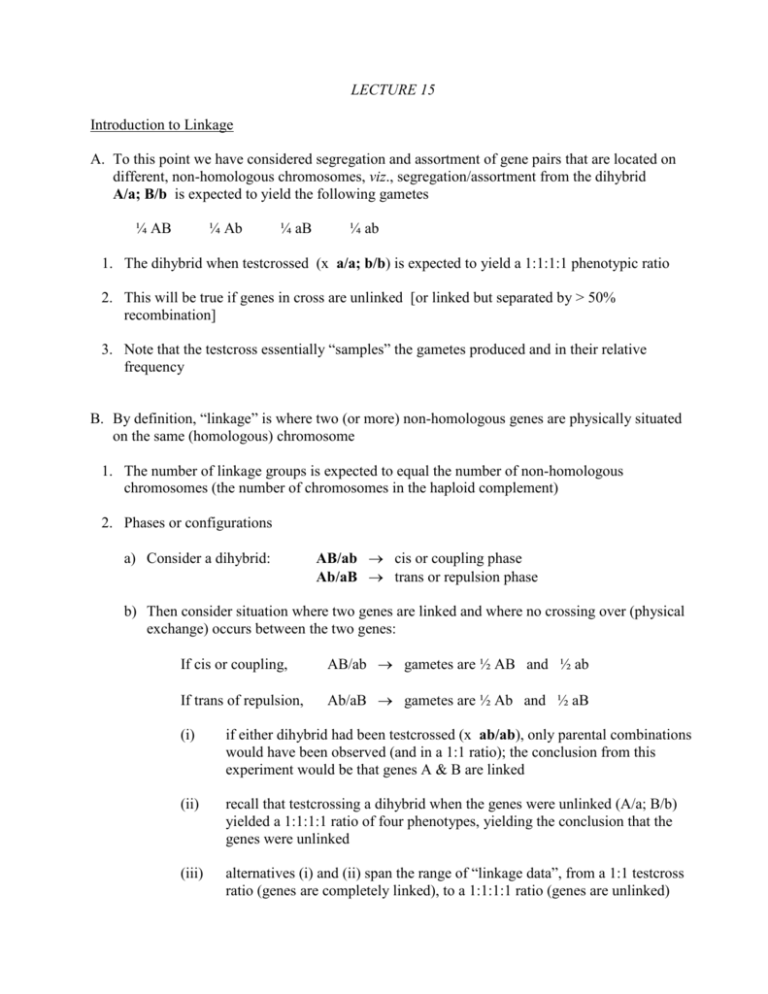
LECTURE 15 Introduction to Linkage A. To this point we have considered segregation and assortment of gene pairs that are located on different, non-homologous chromosomes, viz., segregation/assortment from the dihybrid A/a; B/b is expected to yield the following gametes ¼ AB ¼ Ab ¼ aB ¼ ab 1. The dihybrid when testcrossed (x a/a; b/b) is expected to yield a 1:1:1:1 phenotypic ratio 2. This will be true if genes in cross are unlinked [or linked but separated by > 50% recombination] 3. Note that the testcross essentially “samples” the gametes produced and in their relative frequency B. By definition, “linkage” is where two (or more) non-homologous genes are physically situated on the same (homologous) chromosome 1. The number of linkage groups is expected to equal the number of non-homologous chromosomes (the number of chromosomes in the haploid complement) 2. Phases or configurations a) Consider a dihybrid: AB/ab → cis or coupling phase Ab/aB → trans or repulsion phase b) Then consider situation where two genes are linked and where no crossing over (physical exchange) occurs between the two genes: If cis or coupling, AB/ab → gametes are ½ AB and ½ ab If trans of repulsion, Ab/aB → gametes are ½ Ab and ½ aB (i) if either dihybrid had been testcrossed (x ab/ab), only parental combinations would have been observed (and in a 1:1 ratio); the conclusion from this experiment would be that genes A & B are linked (ii) recall that testcrossing a dihybrid when the genes were unlinked (A/a; B/b) yielded a 1:1:1:1 ratio of four phenotypes, yielding the conclusion that the genes were unlinked (iii) alternatives (i) and (ii) span the range of “linkage data”, from a 1:1 testcross ratio (genes are completely linked), to a 1:1:1:1 ratio (genes are unlinked) 2 C. Now consider crossing over – physical exchange between homologous pair of chromosomes 1. In the dihybrid AB/ab a) If there is no crossing over between genes A & B, gametes are AB and ab → parental types b) If there is crossing over between genes A & B, gametes are Ab and aB → recombinant types c) Note that which is parental and which is recombinant reverses if the dihybrid is in the trans (repulsion) configuration, i.e., in the dyhbrid Ab/aB Ab and aB → parental types AB and ab → recombinant types 2. Crossing over occurs during the pachynema stage of Prophase I (Meiosis I) when the chromosomes are at the so-called “four-strand” or “tetrad” stage, i.e., the chromosomes have been replicated but segregation/assortment have yet to occur a) Consider sister versus non-sister chromatids and sister versus non-sister chromosomes (i) Crossing over can occur between both sister and non-sister chromatids; both types of exchange can have genetic consequence but only exchanges between non-sister chromatids involve exchanges between chromatin from different lines of descent (i.e., maternal and paternal) and represent genetic recombination b) Because crossing over occurs at the four-strand stage, products of crossing over must be considered from that perspective; consider products from a single tetrad in a dihybrid AB/ab where a single exchange occurs between genes A & B (i) Expected consequences from a single tetrad are ¼ AB ¼ Ab ¼ aB ¼ ab (1:1:1:1 in a testcross) (ii) Note that on average there is usually one crossover per tetrad (iii) Thus, from one tetrad with a single crossover, recover 50% parentals & 50% recombinants, and that this is the same ratio as expected from a testcross of a dihybrid where the genes A & B are unlinked! (iv) What would happen if the genes were linked but the dihybrid was in the trans (repulsion) configuration? 3 D. Frequency of crossing over: 1. Between any two (linked) genes, crossing over is a chance event; given that on average only one crossover occurs per tetrad, one would not necessarily expect a crossover to occur between any two genes in any given tetrad a) If crossing over occurs randomly along a chromosome, the chance that a crossover will occur between any two genes should be a function of the distance between the genes, i.e., the further apart are any two genes, the more likely a crossover will occur between them, and conversely, the closer are any two genes, the less likely a crossover will occur between them b) By definition: % crossing over = the proportion of tetrads that have an exchange between two genes % recombination = the proportion of recombinants c) Consider a sample of five tetrads: (i) at 100% crossing over, there is (a maximum) of 50% recombination, and the frequency of gametes observed in a dihybrid will be the same as independent assortment despite the fact that the genes are linked (ii) note that the range between 50% recombination and 0% recombination indicates genes are linked; note also that percentage of parentals will always be greater than percentage of recombinants unless the genes are unlinked or separated by more than 50% recombination E. Linkage mapping: 1. Because the probability of a crossover occurring between any two genes is primarily a function of chromosomal distance, one should be able to utilize crossover occurrences as a means to estimate “distance” between genes, and hence construct a “map” By definition, 1% recombination = 1 map unit (centiMorgan) 2. Two-point (factor) mapping: Example: two sex-linked genes in Drosophila: ♀♀ sn+/-; wild-type sn/sn: singed bristles ♂♂ sn+/Y; wild-type sn/Y: singed bristles ♀♀ w+/-; wild-type w/w; white eyes ♂♂ w+/Y; wild-type w/Y; white eyes 4 a) Testcross a dihybrid → ♀ (sn+, sn – / w+, w) x and score F 1 ♂♂(sons): results are given below Phenotype singed wild-type singed, white white Number ♂ sn w/Y, Genotype sn w+/Y sn+ w+/Y sn w/Y sn+ w/Y 184 64 66 186 500 b) Given these data, one can accomplish the following: (i) determine the allelic configuration in the dihybrid (tester) ♀ (ii) determine the % recombination (map distance) between the two genes c) The data indicate linkage (i.e., the four genotypes are clearly not in a 1:1:1:1 ratio), and given that parentals must be in excess (relative to recombinants), the allelic configuration in dihybrid can be deduced straightforwardly sn w+ and sn+ w are in excess: ergo, the dihybrid ♀ was they must be parentals, and hence stem from tetrads where there was no exchange between the two genes, i.e., the dihybrid ♀ was in the trans configuration sn w+ / sn+ w d) The map distance between the two genes is the % recombination between them % recombination = # recombinants / total = 64 + 66 / 500 = 26% map = sn 26 mu w F. Difficulties with two-factor crosses 1. Do not specify order, i.e., must make a series of crosses for positioning 2. Can underestimate “true” crossover distance a) Odd-numbered crossovers will be scored as single crossovers, and even-numbered crossovers will be scored as no crossovers (parentals) b) Because “map distance” is a function of detected crossovers, the “true” distance can be underestimated; the error will increase with increasing physical distance between any two genes

